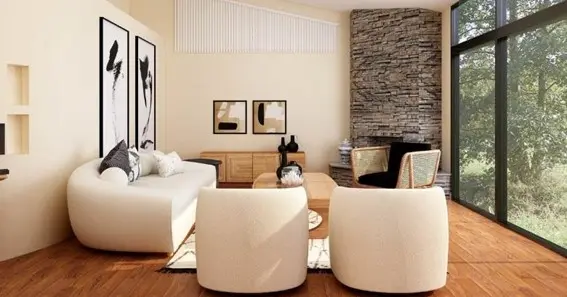In the bustling city of Ontario, California, where the sun graces the skyline with its warm glow for the better part of the year, maximizing natural light in one’s home isn’t just a design afterthought—it’s a crucial aspect of living. The benefits of inviting more sunlight into your abode stretch far beyond the mere aesthetic; it’s about crafting a space that’s energy-efficient, mood-enhancing, and health-promoting. Ontario’s unique blend of urban living with close proximity to nature offers a unique backdrop for residents to harness the power of natural light. In this article, we’ll explore various strategies for Ontario homeowners and beyond, to brighten their homes with sunlight, turning them into luminous sanctuaries that energize and uplift.
Use Mirrors Strategically
A simple yet profoundly effective way to enhance the natural light in your home is through the strategic placement of mirrors. Mirrors reflect light, bouncing it into areas of the room that might otherwise be shrouded in shadows. By positioning a large mirror directly across from a window, or by creating a gallery wall of smaller mirrors on a side adjacent to a light source, you can double the amount of sunlight illuminating your space. This trick not only brightens the room but also creates an illusion of depth, making smaller spaces appear larger and more inviting.
Also Read N: Things to Consider When Planning a Bathroom Renovation
Consider Window Replacement
Natural light’s journey into your home is largely contingent on the size and quality of your windows. For those in Ontario and similar locales, window replacement presents a golden opportunity to enhance this entryway for sunlight. Upgrading to larger, more energy-efficient windows not only increases the amount of light that can flood into your rooms but also improves thermal insulation. Companies specializing in window replacement offer various options that balance aesthetics with functionality, ensuring your home stays bright and temperature-controlled. For residents of Ontario window replacement is a worthwhile investment, with experts like Design Windows and Doors ready to assist in selecting the perfect windows to maximize light and elevate your living space.
Also Read P: Exploring Mount Blackburn
Choose Lighter Paint Colors
The color palette of your walls can significantly impact how your home interacts with natural light. Darker shades absorb light, dimming the brightness of a room, while lighter colors reflect it, amplifying the natural light present. Repainting your walls with light, neutral tones such as whites, creams, or soft pastels can transform your space, making it appear brighter, larger, and more welcoming. This is a relatively affordable and impactful way to enhance the natural illumination in your home, creating an environment that feels both serene and vibrant.
Install Glass Doors
Incorporating glass doors into your home’s design is another effective strategy for maximizing natural light. Replacing solid exterior or interior doors with glass alternatives allows sunlight to flow freely between spaces, unimpeded by opaque barriers. Options like sliding glass doors or French doors not only invite more light into your home but also serve as elegant architectural elements that blend indoor and outdoor living. This approach is particularly effective in communal areas like living rooms, kitchens, and dining spaces, where maximizing light enhances the ambiance and usability of the space.
Opt for Sheer Curtains
While window treatments are essential for privacy and controlling light levels, heavy, dark curtains can significantly reduce the amount of natural light entering a room. Opting for sheer curtains offers a compromise, diffusing sunlight to illuminate your space softly while still providing a degree of privacy. Sheer curtains allow you to enjoy the benefits of natural light throughout the day without the harshness of direct sunlight, creating a soft, evenly lit environment that feels open and airy.
Trim Outside Foliage
The natural light entering your home can be significantly obstructed by overgrown foliage outside your windows. Trees, shrubs, and overhanging branches that block sunlight should be regularly trimmed to ensure your interiors remain bright and welcoming. This not only maximizes the amount of sunlight streaming into your home but also maintains the health of your plants by promoting proper growth and air circulation. Regular maintenance of outside foliage can transform previously shadowed areas into vibrant spaces filled with natural light.
Use Reflective Surfaces
Integrating reflective surfaces into your home decor can dramatically increase the amount of light in your living spaces. Consider incorporating metallic fixtures, glossy floor finishes, or mirrored furniture pieces to bounce light around the room. Reflective backsplashes in kitchens and bathrooms are particularly effective, as they can significantly brighten these often smaller spaces. By thoughtfully placing these reflective elements throughout your home, you can enhance the overall brightness and create a more open and airy atmosphere.
Install Tubular Skylights
In areas of your home where traditional windows or skylights are not feasible, tubular skylights offer an innovative solution to bring in natural light. Tubular skylights are especially useful for lighting up interior rooms, hallways, or closets, providing a cost-effective way to enhance natural light without the need for major renovations.
Optimize Your Furniture Layout
The arrangement of furniture in your home can have a surprising effect on how well natural light is distributed. Bulky, tall furniture pieces placed near windows can block sunlight, casting shadows and darkening your space. By optimizing your furniture layout, ensuring that sofas, bookcases, and other large items do not obstruct windows, you can maximize the flow of natural light. Consider low-profile furniture or pieces with slim silhouettes for areas near windows to keep your spaces bright and open.
Conclusion
Incorporating more natural light into your home involves a combination of creative design choices and practical adjustments. From the strategic placement of mirrors and the selection of sheer curtains to the installation of tubular skylights and the optimization of your furniture layout, each strategy plays a crucial role in enhancing the brightness and energy of your space. Embracing these methods not only improves the aesthetic appeal of your home but also promotes a healthier, more sustainable lifestyle by maximizing the use of natural resources. As we strive to create more inviting and vibrant living environments, the thoughtful incorporation of natural light stands out as a key element in achieving a balanced, harmonious home.










